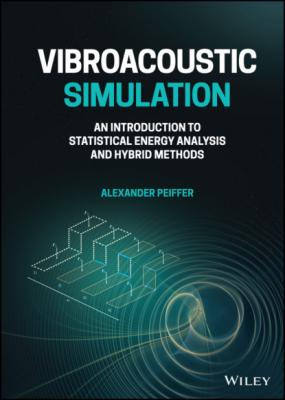Vibroacoustic Simulation. Alexander Peiffer
Чтение книги онлайн.
Читать онлайн книгу Vibroacoustic Simulation - Alexander Peiffer страница 35
 is used in one dimensional form.
is used in one dimensional form.
2.3.1 Harmonic Waves
According to D’Alambert every function of the form p(x,t)=Af(x−c0t)+Bg(x+c0t) is a solution of the one-dimensional wave equation. In the following we will consider harmonic motion or waves so we replace the functions f and g by the exponential function with
and get
The first term of the right hand side of this equation is travelling in positive directions, the second in negative directions2. Harmonic waves are characterized by two quantities, the angular frequency ω and the wavenumber k. The first is the frequency (in time) as for the harmonic oscillator, and the second is a frequency in space. A similar relationship can be found between the time period T and the wavelength λ. Space and time domains are coupled by the sound velocity c0 as shown in Table 2.1.
Table 2.1 Quantities of wave propagation in time and space domains.
| Name | Time | Space | ||
|---|---|---|---|---|
| Symbol | Unit | Symbol | Unit | |
| Period | T | s | λ=c0T | m |
| Frequency | f=1T | s −1(Hz) | (⋅)=1λ | m −1 |
| Angular frequency | ω=2πf=2πT | s −1 | k=2πλ=ω/c0 | m −1 |
The time integration in Equation (2.31) corresponds to the factor 1/(jω) and reads in the frequency domain:
For one-dimensional waves in the x-direction this leads to:
Depending on the wave orientation the ratio between pressure and velocity is given by:
In accordance with the impedance concept from section 1.2.3 we define the ratio of complex pressure and velocity as specific acoustic impedance z
also called acoustic impedance. For plane waves this leads to:
Figure 2.3 One-dimensional harmonic waves travelling in the positive x-direction (c0=2m/s, T=2.2s). Source: Alexander Peiffer.
z0=ρ0c0 is called the characteristic acoustic impedance of the fluid. The specific acoustic impedance z is complex, because for waves that are not plane the velocity may be out of phase with the pressure. However, for plane waves the specific acoustic impedance is real and an important fluid property.
The above description of plane waves can be extended to three-dimensional space by introducing a wavenumber vector k.
2.3.2 Helmholtz equation
Entering (2.40) into the wave Equation (2.27) provides
The ejωt term is often omitted and with k=ω/c0 we get the homogeneous.
2.3.3 Field Quantities: Sound Intensity, Energy Density and Sound Power
A sound wave carries a certain amount of energy that is moving with the speed of sound. We start with the instantaneous acoustic power Π:
F is the force acting on a fluid particle and v the associated velocity. The acoustic intensity I is defined as the power per unit area A=An